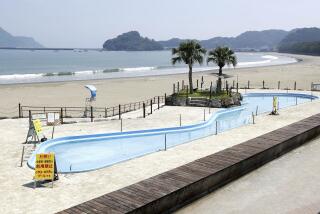A String of Earthquakes Strikes Japan, Killing 18
- Share via
TOKYO — A series of strong earthquakes staggered Japan on Saturday, a quick succession of jolts that ripped across the northern part of the country, killing at least 18 people and injuring about 1,000.
Roads buckled and houses bounced off hillsides in the Niigata region about 160 miles north of Tokyo. Doctors said a 2-month-old boy died of shock. Other victims included three children buried in the rubble of their home and a 70-year-old woman who officials said also died of shock after she took shelter under a table.
There also were reports of people buried under crumpled houses or in mudslides triggered by the tremors. Typhoon rains just four days earlier had loosened soil and rocks in the region, and officials warned that more landslides were possible.
The quakes roiled the ground and left buildings swaying in Tokyo, but no injuries were reported in the capital.
The first and largest quake was centered 12 miles below ground, a relatively shallow depth, at 5:56 p.m. near the Sea of Japan. The magnitude 6.8 tremor tipped cars of a Tokyo-bound bullet train off the rails, reportedly the first time an earthquake had derailed the famous shinkansen. No one on the train was injured.
Other shocks swiftly followed. The next hit at 6:03 p.m., followed by another at 6:12 p.m., with three more significant tremors occurring within the hour. Two of those measured above 6 in magnitude near their epicenters, strong enough to send objects flying off shelves and make it difficult to stand.
Television stations, which cut to live coverage at the first tremor, showed images of their studios rocking in subsequent quakes. By midnight, officials had measured 234 aftershocks.
“There were four to five jolts so strong we couldn’t keep standing without grabbing something like a desk,” Toshio Kasuga, an official in the town of Takayanagi, told Kyodo News Service. “I saw some landslides on a hillside on my way to the office.”
The quake was less deadly than it might have been because it hit hardest in a largely rural area. Nor were there many fires -- which can do more damage than the tremors. Gas mains shut off automatically, and firefighters quickly extinguished a few small blazes in Nagaoka, a city of about 200,000 people.
Landslides posed a greater threat. With its rice-rich fields near the coast, Niigata has one of the flatter landscapes in Japan. But ripples from the quake reached more mountainous areas inland, sending houses sliding down rain-softened hills and onto roads.
Aerial television footage showed jagged tears in main roads and urban areas littered with concrete debris. There were also reports of two collapsed expressway bridges.
The Japanese government dispatched 11 military helicopters to the region to assess the damage. Phone lines were down in parts of Niigata, and hospitals reported a deluge of patients. Officials said about 61,000 people were evacuated from their homes as a precaution.
The Japanese will keep a close eye on their government’s response to the quake. Last week, some grumbled about the authorities’ handling of evacuations before the late-season typhoons. Some local officials reportedly were slow to order people from their homes despite warnings of danger.
The severe typhoons had jangled nerves on this archipelago of Pacific islands. A record 10 typhoons have made landfall in Japan this season, killing more than 200 people and injuring more than 2,000. Experts say warmer waters in the western Pacific have increased the severity of typhoons striking Japan.
Normally stoic about their vulnerability to natural disasters, the Japanese have become edgier this year. A poll conducted last week for the newspaper Yomiuri Shimbun showed that more than 90% of respondents were concerned about environmental problems such as global warming, more than those who expressed fear of North Korea.
Some of that nervousness may have its roots in the fact that the typhoons and earthquakes are hitting places unaffected in recent memory. Not only has this year’s typhoon season been longer than usual, but typhoon-related flooding hit areas accustomed to mild weather.
And the area most affected by Saturday’s earthquake had not been hit this hard for 176 years, since a 6.9 magnitude quake hit Sanjo city, Niigata’s largest, killing 1,400 people in 1828.
More to Read
Sign up for Essential California
The most important California stories and recommendations in your inbox every morning.
You may occasionally receive promotional content from the Los Angeles Times.













